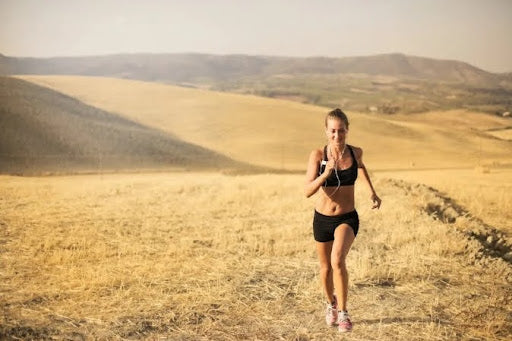Many people believe that leg training is the most crucial aspect of running. However, gluteal training is also an integral part that should not be overlooked. The state of your gluteal muscles is closely related to stability during running. Having well-developed and powerful gluteal muscles can not only enhance your running performance but also reduce the risk of injury while running.
Dr. Romanov wrote in an article, "If I were to recommend one training that is most important for runners, I would suggest gluteal strength training." The stability and power of the gluteal muscles can help to channel the momentum throughout your body as you run. To put it bluntly: stronger glutes = a better running experience.
Although different sports require varying levels of physical fitness, strength training is an indispensable part of most sports. In running, the focus of strength training is primarily on the lower limbs and the gluteal muscles. This article will discuss gluteal strength in detail.

Understanding Your 'Glutes'
One common mistake in running is leaning forward, which can be attributed to weak gluteal strength. Training these muscles can help maintain proper body posture while running. A sedentary lifestyle, characterized by long periods of sitting, can have adverse effects on the body, most notably on the gluteal muscles. Prolonged sitting can lead to the degeneration of the gluteal muscles, making them weak and ineffective.
When running, the role of the gluteal muscles is to help absorb the impact from the ground. If these muscles are compromised due to a lack of use, the impact is then absorbed by other muscles or joints in the legs. If the joints are left to handle this impact, the situation can become more serious, leading to common running injuries such as runner's knee, lower back pain, and shin splints. These injuries may be caused by weak gluteal muscles that, after prolonged running, cannot continue to absorb the impact, leaving the joints to bear the burden.
Different running postures can lead to different outcomes. If the impact is concentrated around the shin, shin splints may occur. If the impact is focused around the knee, various knee pains can result. Most people can locate their gluteal muscles and are familiar with some exercises that target these areas. However, to fully train the gluteal muscles, a deeper understanding is necessary.
The gluteal muscles are primarily composed of three overlapping muscle groups, arranged from innermost to outermost as follows: the gluteus minimus, the gluteus medius, and the gluteus maximus. The size of these muscles increases progressively from the innermost to the outermost layer. As illustrated:
The gluteus minimus and gluteus medius have similar functions. When they contract, they allow the thigh to move outward. The anterior portion of these muscles causes internal rotation of the thigh, while the posterior portion causes external rotation. Additionally, both muscles contribute to stabilizing the gluteal region. The gluteus maximus has a slightly different role, allowing not only external rotation but also extension and lateral rotation of the hip.

Strengthening Your Gluteal Muscles
Weakness in the gluteal muscles, like in other parts of the body, is mainly due to a lack of exercise and prolonged inactivity. Here are a few simple and effective gluteal exercises that can activate the gluteus maximus, medius, and minimus. Choose 3-5 exercises for each training session. It's important to perform the movements correctly and to feel the engagement of the gluteal muscles during the effort.
- Bridge (Glute Lift): Sit on the floor with your hands behind you, palms down and fingers pointing to the side. Extend one leg forward for support and keep the other leg lifted. Raise your hips as high as possible, then return to the starting position and repeat 10 times before switching legs. This exercise primarily targets the gluteal muscles (upper and lower gluteus maximus) and the hamstring muscles (biceps femoris, semitendinosus, and semimembranosus). Engage your glutes, not your lower back.
- Standard Squats: Stand with your feet twice the width of your shoulders, maintain an upright posture, and look straight ahead. Bend your knees and lower your body until your thighs are parallel to the ground, ensuring your knees do not extend past your toes. Squats are an effective way to train the gluteal and thigh muscles without equipment. To increase the intensity of the squats, you can use a backpack filled with books or other weights as a substitute for a barbell. Start with a light load, such as 10 to 20 kilograms, and gradually increase the weight. It is recommended to practice once a week, with each set consisting of 12-15 repetitions and 3-5 sets in total, resting for 30 seconds to 1 minute between sets.
- Prone Leg Lifts: Lie prone with your hands naturally placed at your sides. Raise one leg upward, keeping the thigh as high off the ground as possible. This exercise primarily targets the gluteus maximus. It is recommended to perform 20-30 repetitions before switching to the other leg, with 3-5 sets per side.
- Lunges: With your left foot forward and your right foot back, slightly bend both knees and place your weight on your left foot. Lower your body by bending your knees into a lunge position until your left knee is at a 90-degree angle, then use the power of your front leg to return to the starting position. This is another form of a leg extension exercise that primarily targets the gluteus maximus. It is suggested to perform 15-20 repetitions before switching the front and back legs, with 3-5 sets per side. Start with bodyweight and, once the movement is mastered, you can progress to weighted exercises.
- Kneeling Leg Lifts: Begin in a kneeling position on a mat, supporting your upper body with your arms, elbows slightly bent. Your lower body should be in a kneeling position with your knees on the ground, engaging your abdominal and lower back muscles to keep your core stable and your body aligned. Then, lift one leg upward, maintaining a bent knee, and hold at the top for about two seconds before slowly lowering it. Stop lowering when your big toe or knee lightly touches the ground, and immediately lift the leg again. Kneeling leg lifts are a fundamental gluteal exercise targeting the gluteus maximus. It is suggested to perform 10-20 repetitions before switching to the other leg, alternating for 3-5 sets, with a rest of half a minute to one minute between sets. Since you switch legs, you can continue without rest if you can manage. The training volume provided is a suggestion and can be adjusted according to individual levels. For those new to strength training, starting with 2-3 sessions per week, with one set per session, can help to tighten muscle tissue. Beginners in running can also follow this training plan.



